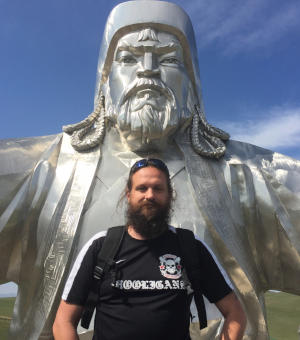Dr John Pouncett
ORCID: 0000-0001-8387-4499
Research Interests
GIS; spatial analysis; landscape archaeology; archaeological prospection; lithic analysis; prehistoric burial mounds; historic woodlands; isoscapes and geographic assignment
Geographic Areas
Europe (Britain, Crete, Ireland), Central America (Carribean)
Research Activities
I have a long-standing interest in GIS, spatial analysis and landscape archaeology, with a particular emphasis on spatial modelling of stable isotope data, the role of web-GIS in collaborative research, and Neolithic occupation and stone working on the Yorkshire Wolds. Recent and ongoing research includes identification of the likely sources of the raw materials used in prehistoric wood carvings from Pitch Lake (Trinidad), determination of the possible geographic origins of the individuals cremated and buried in the Aubrey Holes at Stonehenge (UK), development of the web-mapping application for the Atlas of Hillforts of Britain and Ireland, creation of a map of biologically available strontium for Ireland, and geophysical and topographic survey on Lower Gypsades hill at Knossos (Crete). I am an active member of Computer Applications & Quantitative Methods in Archaeology (CAA) – I am currently an elected officer (Treasurer) on the CAA Executive Steering Committee and a co-opted member of the Scientific Committee as the Local Organiser for CAA2020 Oxford.
Research Awards
Esri UK 2018 Customer Success Award for Community Engagement
Links
- Atlas of Hillforts of Britain and Ireland
- Black Pitch, Carved Histories
- CAA2020 Oxford: Inside Information
- Computer Applications and Quantitative Methods in Archaeology
- Flow of Ancient Metals across Eurasia
- Knossos, Gypsades
- Stone interchanges within the Bahama archipelago
Undergraduate teaching
Undergraduate lecturer for:
- FHS core paper 3: Landscape and Ecology
Postgraduate teaching
Postgraduate taught course options in:
I am happy to supervise on spatial archaeology or landscape archaeology, including studies on GiS, spatial analysis, remote sensing, archaeological prospection, ancient woodlands, isoscapes and geographic assignment.
Current students
| Digital Technology, Cultural Heritage, and the Creation of Landscapes of Power. Savannah Milton | DPhil Archaeology | Supervisors: Lambros Malafouris and John Pouncett |
| Weaving Material Mind Maps: Cognitive Networks Based on the Semiotic Variants of Dolmens on the Korean Peninsula Hoin Song | DPhil Archaeology | Supervisors: Lambros Malafouris and John Pouncett |
| Early Anglo-Saxon barrow burials in England: spatial analysis and contextualisation of the Sixth and Seventh Century nationwide funerary landscape. Wyatt Wilcox | DPhil Archaeology | Supervisors: John Pouncett and Helena Hamerow |
| Local-scale network and connectivity in in-land water proximity sites of the Maya Lowlands during the Maya periods using emerging technologies Cristina Gonzalez | DPhil Archaeology | Supervisors: John Pouncett and Alexander Geurds |
| Pirate Societies: An Archaeology of Liminal Maritime Spaces Adam Dawson | DPhil Archaeology | Supervisors: John Pouncett and Damian Robinson |
| Military and Literary Landscapes of the Other: understanding castle building in Medieval North Wales Meg Kirkpatrick | DPhil Archaeology | Supervisors: John Pouncett and Andrew Wilson |
| Nuna Nalluyuituq/The Land Remembers: Spatial technology, collaborative community engagement, and capacity building in Southwest Alaskan cultural landscapes Jonathan Lim | DPhil Archaeology | Supervisors: Rick Schulting and John Pouncett |
Past students
| Modelling Seafaring in Iron Age Atlantic Europe Karl Smith (2020) ORA | DPhil Archaeology | Supervisors: Rick Schulting and John Pouncett |
| Underwater Acoustic Localization and Referencing: An Enhanced Subsurface Positioning Method for Archaeological Data Collection of Submerged Cultural Resources Matthew Thompson (2020) ORA | DPhil Archaeology | Supervisors: John Pouncett and Damian Robinson |
Key words: digital archaeology, land use, mobility, woodlands, spatial analysis, GIS, landscape, archaeological prospection, later prehistory, multi-period, Europe, Eurasia




